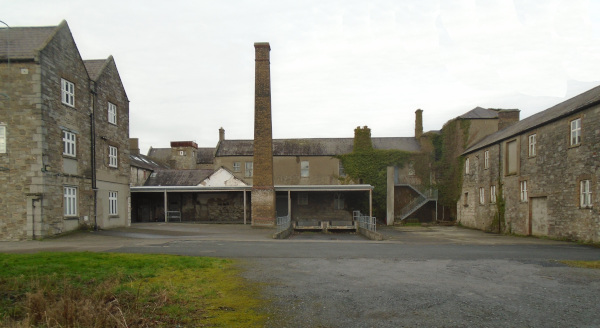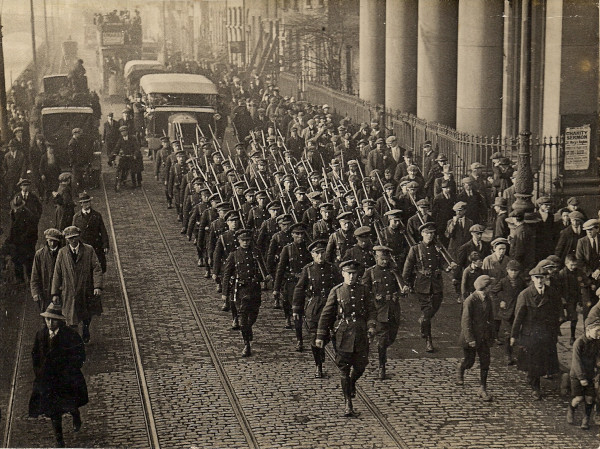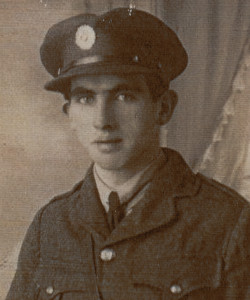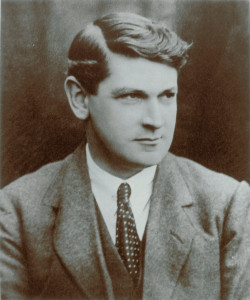Establishing the National Army in 1922
The Celbridge connection
Published in the Liffey Champion, 22nd January 2022
January 1922 was a momentous month. The Anglo-Irish Treaty was passed on the 7th of January then seven days later a new Provisional Government was set up headed by Michael Collins. Two days later, the new government took control of Dublin Castle the seat of British administration in Southern Ireland. Another important function of the provisional government was the establishment of a new Irish National army which would take possession of the British army barracks as they were vacated. There was a very significant Celbridge connection to the formation of the National army.
Michael Collins envisaged the new army being built around the existing IRA, but throughout January the split over the Treaty particularly within the IRA widened. This had significant consequents in the IRA where many of the leadership and rank and file of the movement took opposite sides in the treaty divide. In the Dublin area and East Leinster, IRA divisional commanders adopted conflicting viewpoints. Oscar Trainer who was in charge of the two Dublin Brigades which territorially included areas of County Wicklow took an anti-Treaty position. The Eastern Division with its headquarters in Dunboyne covering Meath and North Kildare with Sean Boylan in charge adopted a largely pro-Treaty viewpoint. The Carlow Brigade which included southern Kildare under Liam Stack were also pro-Treaty.
Disunity in the IRA caused a rethink by the Provisional Government and a decision was made to establish a new National army from scratch, specifically from units loyal to Michael Collins. Within the Dublin Brigade area a unit of the IRA, the Dublin Guard was directly under the authority of Collins and Richard Mulcahy the Minister of Defence. They had been formed from two units, the Squad and the Dublin Active Service Unit [ASU] following heavy losses that occurred during the burning of the Custom House. It was personnel from this unit that were earmarked to become the first contingent of the new Irish army.
Another problem emerged, the first recruits would have to undertake initial training and a suitable training or military academy would have to be found. A training camp within the Dublin Brigade area could generate tensions and even hostility from the anti-Treaty leadership in Dublin. Two suitable IRA camps close to the city but outside the Dublin Brigade area were situated at Ballymacoll between Dunboyne and Maynooth and the Workhouse building in Celbridge. While the Ballymacoll camp was in a rural location in which a farmhouse was the only major building the Celbridge camp was an abandoned complex with several vacant buildings. Not surprisingly the Celbridge Camp, which was within half a mile from the centre of Celbridge and twelve miles from Dublin, was chosen.

Celbridge Workhouse.
Paddy Mullaney the local IRA battalion commander had authority over the two IRA camps. Although he was anti-Treaty a permanent split in the IRA had not occurred at the time. The pro-Treaty membership within the general headquarters staff of the IRA who were in the majority still controlled the movement at this time. Mullaney had no difficulty in obeying orders from his superiors and facilitated the new army training camp.
Arrival in Celbridge
In late January a unit of the Dublin Guard consisting of three officers with Captain Paddy O’Daly in charge, left their base in the cellars of the Plaza Hotel, Dublin and duly arrived in Celbridge to undertake training. They were to become the nucleus of the new National Army. O’Daly was well-known having served as head of Michael Collins’s Squad that had been so successful in countering British intelligence efforts during the War of Independence. Joe Leonard another prominent member of the Squad was given the rank of Lieutenant.
The third officer, Lieutenant Pádraig O’Connor was well-known to Celbridge having been raised in the town where his father, Sean O’Connor was an Irish teacher and an IRB organiser in the period prior to 1916. O’Connor during the War of Independence was a member of the Dublin ASU and obtained a reputation as a successful activist. He had been in charge in a number of engagements by the ASU including the Ballyfermot Bridge Ambush in July 1921. Details of his exploits have been published in his biography Sleep Soldier Sleep.
O’Connor and his colleagues when joining the new unit sought advice from Oscar Traynor and he suggested that the new standing army would be small and select. IRA officers would be recruited in their own rank to the new army which would be restricted to 4,000 men, almost the same size as the IRA in the two Dublin Brigades and as a result the prospects of promotion would be slim.
Traynor was an opponent of the Treaty and his remarks may have been an apparent attempt to discourage the men from joining. He would not advise for or against joining but implied that a civilian occupation would be a better prospect.
However, the prospects of a permanent full-time job in the new Irish army paying a weekly wage of £3. 10s. would have been a decisive factor in choosing a career in the new army.
A uniform somewhat different from the volunteer uniform was designed for the new army and the recruits were sent in pairs to be measured in Co-Op Tailors, Abbey St. Dublin.
One of the men joining was Jimmy McGuinness who participated in the Stacumny Ambush close to Celbridge the previous July. On that occasion his use of a Thompson Machinegun allowed some trapped IRA participants to escape during a gunfight with regular British soldiers.
It wasn’t all harmony at the Celbridge camp with a serious disturbance among the men narrowly avoided. Some former Squad members and volunteers that that had been arrested during the Burning of the Custom House had criticised Paddy O’Daly for his tactics during the attack and this caused tensions. When they encountered O’Daly on their arrival in Celbridge a row broke out. Hard names were called and guns were even drawn before an intervention by impartial members in the camp calmed the disturbance. Some of the perpetrators were quickly appointed to positions away from the camp and this defused the situation.
Michael Collins Inspects the Men in Uniform
During the training period the men had an important visitor. According to Paddy Mullaney, ‘Mick Collins came out to see the first men who were put into uniform’. While some local IRA in the camp including Mullaney were of an anti-Treaty viewpoint they were all friendly to one another at the time. Collins’s visit was the first occasion of a visit to Celbridge by a head of an Irish government.
The men dressed in their uniforms often paraded through the main street in Celbridge and certainly attracted considerable attention particularly from the ladies. Describing the reaction a proud Padraig O’Connor pointed out that ‘in our new uniforms we would parade the village in the evenings and charm the female hearts in the manner of soldiers the world over’.
Close to the end of their stay in Celbridge a small detachment of the National army were sent to guard the Quartermaster General stores at Burke’s Distillery, Westland Row, Dublin and they arrived back to the Celbridge camp on the 31st of January. They brought back rifles for the unit to be used in the takeover of Beggars Bush Barracks which would then become the headquarters of the new army.
The British military at this stage had already withdrawn from some rural barracks and had reduced personnel in others. On the 16th of January, the day Dublin Castle was passed to the Provisional Government, ninety-three RAF personnel from Baldonnell aerodrome and an advance party of thirty artillerymen were shipped out from the North Wall, Dublin. On the 25th of January, Clogheen in County Tipperary and Baltinglass were the first British army stations to be evacuated. The following day it was the turn of two stations in the Glen of Imaal, County Wicklow.
Takeover of Beggars Bush Barracks
The handover of Beggars Bush Barracks the first major British army instillation in Dublin was a small event between officers and officials which took place on the 31st of January. The official ceremony with uniformed National army members from Celbridge occupying the barrack was to take place the following day.
The morning of the 1st of February was a busy morning in the Celbridge camp, equipment including rifles had to be cleaned, polished and the kit packed and loaded. There was a twenty minute period in the morning when they were given instructions in the handling of arms. The unit were not accustomed to rifles as handguns were the favourite and most reliable weapon while engaged in activity in the city during the conflict. So, they practiced sloping arms which would be necessary when changing guards in their new assignment.
A difficulty arose due to the omission by the designers of the leather equipment to provide a bayonet frog with the kit. As a result, the bayonets had to be attached to the rifles at all times. There were no military lorries to transport the men on the first leg of their journey to the Phoenix Park. Instead the selected contingent of 46 men which included three officers: Captain Paddy O’Daly, Lieutenant Paddy Leonard and Lieutenant Padraig O’Connor were transported in charabancs.

Marching along the Quays in Dublin, courtesy of Padraig O’Connor.
The first leg of the journey to Dublin took them to the Gough monument in the Phoenix Park. This monument which was blown up in 1957 was sited close to the Wellington monument on the first roundabout in the park. From there led by the Fintan Lawlor pipe band the contingent marched through Dublin to Beggars Bush. By the time they got to the city centre crowds lined both sides of the street with large numbers gathering as they crossed Grattan Bridge and made their way up Parliament Street. As they passed the City Hall the headquarters of the Provisional Government they were reviewed by Michael Collins and the Arthur Griffith.
From the City Hall they continued their march to Beggars Bush. The barracks had been vacated initially by the Auxiliaries but a contingent of the Australian army remained on and only departed earlier in the day. The most spectacular sight of the takeover was a fully armed native Irish army in uniform replacing non-Irish troops, with the Freeman’s Journal observing that ‘the red coat was replaced by the green coat’. The Irish army contingent were greeted by Richard Mulcahy, Minister of Defence, Eoin O’Duffy, Chief of Staff of the new army and other senior officers.
While this event is regarded as one the most important milestones in the history of the National army, historians fail to point out the significance of the Celbridge connection. The fact that the first National army unit that took over Beggars Bush Barracks were initially formed in Celbridge Barracks needs to be fully recognised and included in the history books.
Sources
- Irish Times, 2 Feb. 1922
- Freeman’s Journal, 2 Feb. 1922
- Leinster Leader, 15 Apr. 1922
- An tÓglach, 7 Apr. 1923
- Paddy Mullaney interview, p. 34 (UCDA, O’Malley notebooks, P17/b/106)
- Eoin Neeson, The Civil War, 1922–23 (Dublin, 1969), p. 89
- John Duggan, A History of the Irish Army (Dublin, 1991), p. 75
- Tony Doohan, A History of Celbridge (Celbridge, 2011), p 96
- Diarmuid O’Connor and Frank Connolly, Sleep Soldier Sleep: The Life and Times of Pádraig O’Connor (Dublin, 2011), p. 67–8, 83–4
- Seamus Cullen, Kildare: The Irish Revolution 1912–23 (Dublin, 2020), pp 109–10


